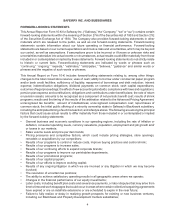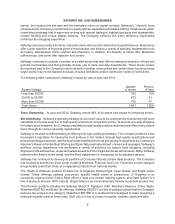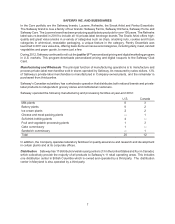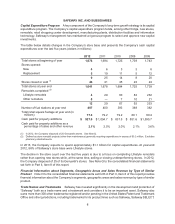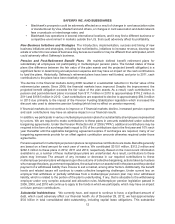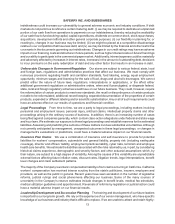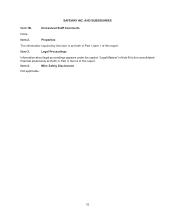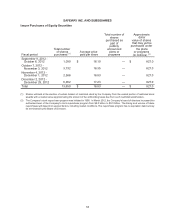Safeway 2012 Annual Report Download - page 25
Download and view the complete annual report
Please find page 25 of the 2012 Safeway annual report below. You can navigate through the pages in the report by either clicking on the pages listed below, or by using the keyword search tool below to find specific information within the annual report.SAFEWAY INC. AND SUBSIDIARIES
13
indebtedness could increase our vulnerability to general adverse economic and industry conditions. If debt
markets do not permit us to refinance certain maturing debt: (i) we may be required to dedicate an unplanned
portion of our cash flow from operations to payments on our indebtedness, thereby reducing the availability
of our cash flow to fund working capital, capital expenditures, dividends on common stock, stock repurchases,
acquisitions, development efforts and other general corporate purposes; (ii) our flexibility in planning for, or
reacting to, changes in our business may be limited; (iii) we might be placed at a competitive disadvantage
relative to our competitors that have less debt; and (iv) we may be limited by the financial and other restrictive
covenants in the documents governing our indebtedness. Changes in our credit ratings may have an adverse
impact on our financing costs and structure in future periods, such as higher interest costs on future financings
and our ability to participate in the commercial paper market. Additionally, interest expense could be materially
and adversely affected by increases in interest rates, increases in the amount of outstanding debt, decisions
to incur premiums on the early redemption of debt and any other factor that results in an increase in debt.
Unfavorable Changes in Government Regulation Our stores are subject to various federal, state, local
and foreign laws, regulations and administrative practices that affect our business. We must comply with
numerous provisions regulating health and sanitation standards, food labeling, energy, equal employment
opportunity, minimum wages and licensing for the sale of food, drugs and alcoholic beverages. We cannot
predict either the nature of future laws, regulations, interpretations or applications, or the effect either
additional government regulations or administrative orders, when and if promulgated, or disparate federal,
state, local and foreign regulatory schemes would have on our future business. They could, however, require
the reformulation of certain products to meet new standards, the recall or discontinuance of certain products
not able to be reformulated, additional record keeping, expanded documentation of the properties of certain
products, expanded or different labeling and/or scientific substantiation. Any or all of such requirements could
have an adverse effect on our results of operations and financial condition.
Legal Proceedings From time to time, we are a party to legal proceedings, including matters involving
personnel and employment issues, personal injury, antitrust claims, intellectual property claims and other
proceedings arising in the ordinary course of business. In addition, there is an increasing number of cases
being filed against companies generally, which contain class-action allegations under federal and state wage
and hour laws. We estimate our exposure to these legal proceedings and establish reserves for the estimated
liabilities. Assessing and predicting the outcome of these matters involves substantial uncertainties. Although
not currently anticipated by management, unexpected outcomes in these legal proceedings, or changes in
management’s evaluations or predictions, could have a material adverse impact on our financial results.
Insurance Plan Claims We use a combination of insurance and self-insurance to provide for potential
liabilities for workers’ compensation, automobile and general liability, property risk (including earthquake
coverage), director and officers’ liability, employment practices liability, cyber risks, terrorism and employee
health care benefits. We estimate the liabilities associated with the risks retained by us, in part, by considering
historical claims experience, demographic and severity factors and other actuarial assumptions which, by
their nature, are subject to a high degree of variability. Among the causes of this variability are unpredictable
external factors affecting future inflation rates, discount rates, litigation trends, legal interpretations, benefit
level changes and claim settlement patterns.
The majority of the Company’s workers’ compensation liability is from claims occurring in California. California
workers’ compensation has received intense scrutiny from the state’s politicians, insurers, employers and
providers, as well as the public in general. Recent years have seen escalation in the number of legislative
reforms, judicial rulings and social phenomena affecting our business. Some of the many sources of
uncertainty in the Company’s reserve estimates include changes in benefit levels, medical fee schedules,
medical utilization guidelines and apportionment. Reversals of reforms by legislation or judicial action could
have a material adverse impact on our financial results.
Leadership Development and Succession Planning The training and development of our future leaders
is important to our long-term growth. We rely on the experience of our senior management, who have specific
knowledge of our business and industry that is difficult to replace. If we are unable to attract and retain highly-



